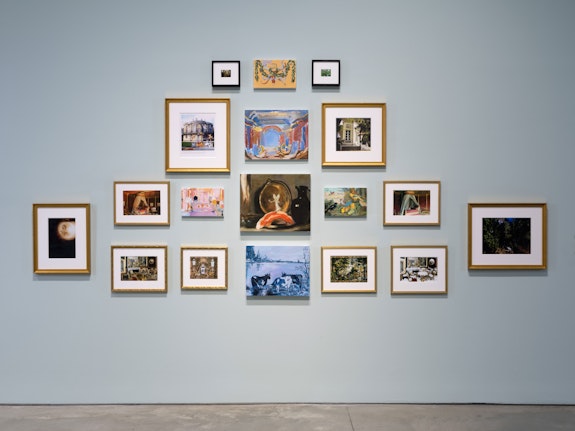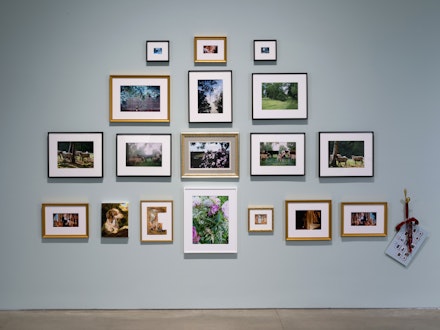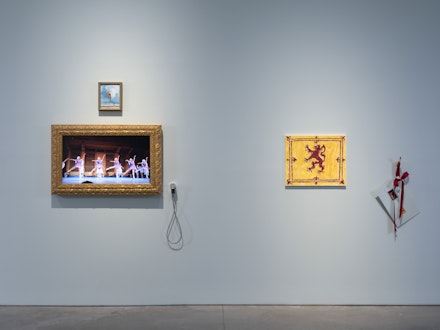ArtSeen
Karen Kilimnik
On View
303 GalleryKaren Kilimnik
November 1 – December 20, 2019
New York
Presented elegantly in St. Petersburg style, akin to salon-style or a Wunderkammer but hung in symmetrical formations, Karen Kilimnik’s self-titled exhibition assembles nearly 80 works (all 2000–present, except two from 1984) of painting, video, photography, collage, and readymade, borrowing imagery from pastoral landscapes, Tsarist Russia, classical and romantic ballet, pop culture, and Hollywood movies. Inverting the hieratic structure operative in many of her sources—coats of arms, aristocratic codes, ballet with its origins in court dance, military pageantry—Kilimnik’s constellations of image and style generate non-hierarchical networks of thought. These networks map an ambitious, unchronological history of domination and violence lurking beneath Western civilization’s idealized images of itself.
One triangular formation of 18 paintings depicts pastoral and Arcadian motifs: manor homes, forested landscapes, a close-up of the lightning bolt in Giorgione’s Tempest (1506–08). Despite their individual charm, in sum these images suggest that the idealization of nature is a means of controlling it, an idea further reinforced by depictions of militaristic control within the grouping: a gilded emblem of Mars floating in a landscape (2012); a loosely painted still (2010) of a costume party scene from the British 1960s spy-fi show The Avengers, catching Bismark, Admiral Nelson, and the two-faced god Janus in provocative juxtaposition.
Another formation consists of a trio: two paintings and a flatscreen monitor set in a lavish, gilt frame, playing clips of ballets by French-born, Russian choreographer Marius Petipa, most notably his lesser-known, joyous The Awakening of Flora (1894, reconstructed 2007) performed by the Pittsburgh Ballet Theatre School (2018). Above the monitor a small painting, the owl, town watch, the flood approaches (2017), depicts a perched owl gazing with consternation over a misty sea. Following the line of its gaze, we encounter My Judith Leiber bag, the royal house of Scotland (2012), a Scottish coat of arms re-appropriated from contemporary kitsch couture and hung some distance from the monitor; its bipedal Red Lion, crudely composed of glitter, claws menacingly in the dancers’ direction. The configuration reads as an allegory of our climate crisis with carefree dancers representing the flora of earth under threat, but their pastoral image itself has contributed to the West’s destructive conception of nature as something man is entitled to dominate at will. As told in the first-person by Flora in Ovid’s Fasti, upon which Petipa’s dance is based, Zephyrus, ostensibly the “gentlest” of the gods of the four winds, granted “the authority for rape” by his brother Boreas, abducted Chloris and subsequently gave her domain over flowering plants—thus she became Flora. Her story recurs throughout art history, most famously in Botticelli’s Primavera (c. 1482) showing captured Chloris’ fright in the clutches of a foul-faced blue Zephyrus.
Another gilt-framed video monitor plays The World at War (2018), 44 minutes of appropriated film and YouTube clips, beginning with studio logos that preface films, such as Columbia studio’s eponymous allegorical figure of the Americas whose classical beauty belies the ruthless colonization of the New World, and J. Arthur Rank studio’s orientalist gong ringing. Those are followed by clips from an international array of fictional films about World War II which Kilimnik selected for their music. Heard one after another, the cheery band numbers that accompany military pageantry absurdly trivialize the institutions they seek to honor. Flanking the video, orientalist patterns and images, such as a Shanghai dragon (2014), as well as a circular painting of a Villeroy & Boch French garden plate (2013), all suggest collecting is yet another means of asserting control. Hanging above all, a 2019 painting of a Delftware clock printed on canvas and affixed with Swarovski crystals stands as a vanitas.
In the gallery’s darkened rear viewing room, a gunmetal gray pirate ship (2019), constructed from a readymade model kit (as are several sculptures of historic tourist sites—the Eiffel Tower, Leaning Tower of Pisa, Louvre—on pedestals in the main room), is silhouetted against a spotlighted unstretched canvas (2019) depicting a painted map of the British Empire, post-American Revolution, with its remaining territories painted pink. Sea monsters swim in three corners, common motifs in period maps representing unknown or “barbaric” regions, contrasting with the stately allegorical figure of Britannia in the upper left. Alone in the room the readymade and the painting ask: What’s more barbaric than the brutality of colonization? And what, other than pomp and style, makes an empire’s imperialism different from common piracy?
Despite her range of sources, Kilimnik does not (and never has) disperse or separate elements, as the moniker “scatter art” which has been misapplied to her work since her late 1980s installations suggests. Rather, she joins elements to spotlight potent mythologies, as in her earlier work on adolescent girl fandom. Her repetition and re-appropriation of motifs, and the sheer volume of work in this exhibition, speak to how the proliferation of fictional images sustains Western society’s destructive myths. Kilimnik reveals, analogous to Hannah Arendt’s “banality of evil,” the elegance of evil in an exhibition that is at first visually seductive and then hauntingly unsettling.




